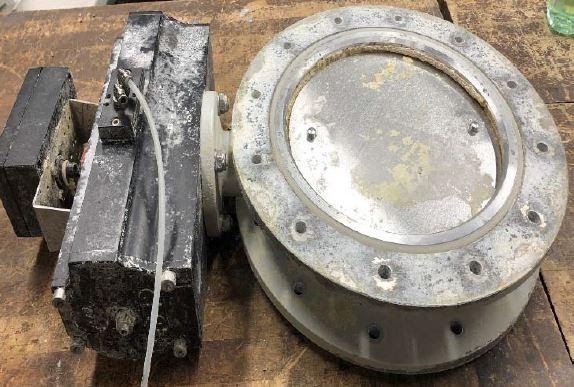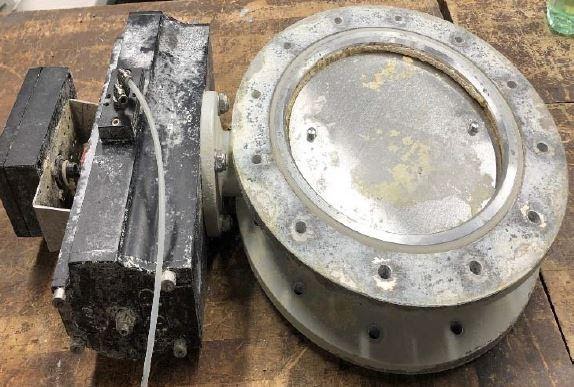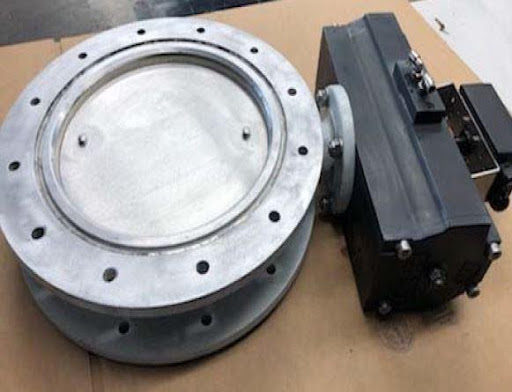
The greatest hurdle in repairing material handling equipment is possessing the knowledge to repair technical specifications unique to each machine. Those with the most experience, background and updated knowledge of these specifications can arguably provide the quickest and most thorough care.
Old parts that are not up to spec can pose contamination risks in a facility, but there are many benefits to repairing them rather than investing in an entirely new part. Any man-made innovation that sees continual use will need to be repaired decades down the line (even robust material handling equipment originating from German designs). If you have a system with one or more aging AZO parts, the solution is simple: call on us to repair them for you!

An example of our work: butterfly valve repair
Recently we had a food manufacturer come to us with a question about a dusty and grimy butterfly valve. This particular valve was located in a hot indoor area. It opened and closed about once every five minutes for around 10 years. The gaskets were brittle and the valve, as a whole, was just worn out. The piece was definitely not operating at total capacity.
AZO specialists like Mike Nichols and James Cato have been repairing parts like these for years. These two took the time to assess the damage, collect the right parts, ensure the seal would work properly and voila:

One major sign that your own butterfly should be replaced includes:
- Vacuum leaking (upon visual inspection of the gasket seal)
As for other equipment, some common signs that a rotary valve (for example) may need to be replaced include:
- Scarring on the inside
- Increased clearances
New rotary valves have tolerances of “five- to six-thousands of an inch.” Once these tolerances increase enough, it becomes necessary to have the valve welded up and re-machined.
Valve or not, any AZO equipment is fair game for these types of repairs. As a company, we haven’t been exceptionally vocal about this kind of repair work, but there are too many benefits as a result of this practice to not highlight and share.
Repairing old parts introduces multiple benefits
When you bring all your equipment back up to spec, it will bring your production back up to spec as well. In the case of the “grimy” butterfly valve, the piece was back to being 100% operational when the AZO team was through with it. The delivery rate of flour coming in was made immensely faster by the rebuild. As a result, production is likely to increase by a significant and noticeable amount (our quick guesstimation would aim somewhere between 6,000 pounds of flour back up to 10,000).
Another benefit to take into consideration is that any time an aging piece of machinery breaks down, there is a chance that parts of it will contaminate active product. Take another look the comparison we’ve presented, and you’ll notice rubber parts missing from the first frame:
.jpg?width=599&name=image3%20(1).jpg)
Fixing up an old piece like a butterfly valve proactively will prevent some likely product contamination as well as keep your production running at high efficiency. We have the tools, the parts, the drawings and the updated knowledge to take care of any AZO-crafted equipment. Many companies have ever-changing rosters of technical minds that would approach repairing equipment, but AZO tends to have a few seasoned material-handling maestros with decades of combined experience. If anybody can do the job of repairing AZO equipment, it’s absolutely AZO.
.jpg?width=512&name=unnamed%20(3).jpg)
For a plethora of informative content related to conveying systems, feel free to check out our free conveying guide. Specific benefits of conveying modes, how to avoid product smearing and more helpful topics are included in “Choosing The Right Pneumatic Conveying Method For Process Material Handling.” AZO has seven decades of experience shaping ingredient automation, so feel free to contact our sales team for any questions on how to help your plant and processes run smoothly.


